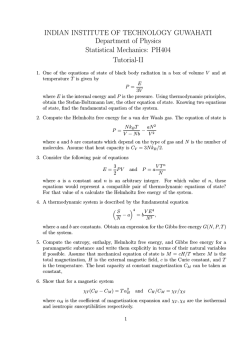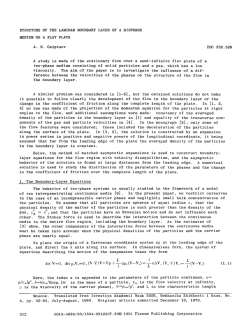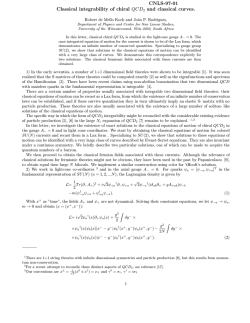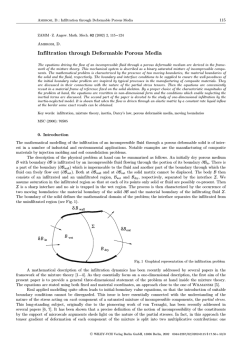
Finite Difference Methods for Elliptic Equations
Numerical Solutions to
Partial Differential Equations
Zhiping Li
LMAM and School of Mathematical Sciences
Peking University
Numerical Methods for Partial Differential Equations
Finite Difference Methods for Elliptic Equations
Finite Difference Methods for Parabolic Equations
Finite Difference Methods for Hyperbolic Equations
Finite Element Methods for Elliptic Equations
Finite Difference Methods for Elliptic Equations
1
Introduction
2
A Finite Difference Method for a Model Problem
3
General Finite Difference Approximations
4
Stability and Error Analysis of Finite Difference Methods
Finite Difference Methods for Elliptic Equations
Introduction
The definitions of the elliptic equations
The definitions of the elliptic equations — 2nd order
A general second order linear elliptic partial differential equation
with n independent variables has the following form:
n
n
2
X
X
∂
∂
+
bi
+ c u = f ,
(1)
±L(u) , ±
aij
∂xi ∂xj
∂xi
i,j=1
i=1
with (the key point in the definition)
n
n
X
X
aij (x)ξi ξj ≥ α(x)
ξi2 , α(x) > 0, ∀ ξ ∈ Rn \{0}, ∀x ∈ Ω. (2)
i,j=1
i=1
Note that (2) says the matrix A = (aij (x)) is positive definite.
4 / 39
Finite Difference Methods for Elliptic Equations
Introduction
The definitions of the elliptic equations
The definitions of the elliptic equations — 2nd order
L – the 2nd order linear elliptic partial differential operator;
aij , bi , c — coefficients, functions of x = (x1 , . . . , xn );
f — right hand side term, or source term, a function of x;
The operator L and the equation (1) are said to be uniformly
elliptic, if
inf α(x) = α > 0.
x∈Ω
n
X
i,j=1
aij (x)ξi ξj ≥ α
n
X
ξi2 ,
α > 0,
(3)
∀ ξ ∈ Rn \ {0}, ∀x ∈ Ω.
i=1
5 / 39
Finite Difference Methods for Elliptic Equations
Introduction
The definitions of the elliptic equations
The definitions of the elliptic equations — 2nd order
P
∂2
For example, 4 = ni=1 ∂x
2 is a linear second order uniformly
i
elliptic partial differential operator, since we have here
aii = 1, ∀i,
aij = 0, ∀i 6= j,
and the Poisson equation
−4u(x) = f (x)
is a linear second order uniformly elliptic partial differential
equation.
6 / 39
Finite Difference Methods for Elliptic Equations
Introduction
The definitions of the elliptic equations
The definitions of the elliptic equations — 2m-th order
A general linear elliptic partial differential equations of order 2m
with n independent variables has the following form:
2m
n
k
X
X
∂
±L(u) , ±
ai1 ,...,ik
+ a0 u = f ,
(4)
∂xi1 . . . ∂xik
k=1 i1 ,...,ik =1
with (the key point in the definition)
n
X
i1 ,...,i2m =1
ai1 ,...,i2m (x)ξi1 · · · ξi2m ≥ α(x)
n
X
ξi2m ,
i=1
α(x) > 0, ∀ ξ ∈ Rn \ {0}, ∀x ∈ Ω. (5)
Note that (5) says the 2m order tensor A = (ai1 ,...,i2m ) is positive
definite.
7 / 39
Finite Difference Methods for Elliptic Equations
Introduction
The definitions of the elliptic equations
The definitions of the elliptic equations — 2m-th order
L – the 2m-th order linear elliptic partial differential operator;
ai1 ,...,ik , a0 — coefficients, functions of x = (x1 , . . . , xn );
f — right hand side term, or source term, a function of x;
The operator L and the equation (4) are said to be uniformly
elliptic, if
inf α(x) = α > 0.
n
X
i1 ,...,i2m =1
x∈Ω
ai1 ,...,i2m (x)ξi1 · · · ξi2m ≥ α
n
X
(6)
ξi2m ,
i=1
α > 0,
∀ ξ ∈ Rn \ {0}, ∀x ∈ Ω.
8 / 39
Finite Difference Methods for Elliptic Equations
Introduction
The definitions of the elliptic equations
The definitions of the elliptic equations
As a typical example, the 2m-th order harmonic equation
42m u = f
is a linear 2m-th order uniformly elliptic partial differential
equation, and 42m is a linear 2m-th order uniformly elliptic partial
differential operator, since we have here
ai1 ,...,i2m (x) = 1, if the indexes appear in pairs;
ai1 ,...,i2m (x) = 0, otherwise.
In particular, the biharmonic equation 42 u = f is a linear 4th
order uniformly elliptic partial differential equation, and 42 is a
linear 4-th order uniformly elliptic partial differential operator.
9 / 39
Finite Difference Methods for Elliptic Equations
Introduction
Steady state convection-diffusion problem — a model problem for elliptic partial differential equations
Steady state convection-diffusion equation
1
x ∈ Ω ⊂ Rn ;
2
v(x): the velocity of the fluid at x;
3
u(x): the density of certain substance in the fluid at x;
4
a(x) > 0: the diffusive coefficient;
5
f (x): the density of the source or sink of the substance.
6
J: diffusion flux (measured by amount of substance per unit
area per unit time)
7
Fick’s law: J = −a(x)∇u(x).
10 / 39
Finite Difference Methods for Elliptic Equations
Introduction
Steady state convection-diffusion problem — a model problem for elliptic partial differential equations
Steady state convection-diffusion equation
For an arbitrary open subset ω ⊂ Ω with piecewise smooth
boundary ∂ω, Fick’s law says the substance brought into ω by
diffusion per unit time is given by
Z
Z
J · (−ν(x)) ds =
a(x)∇u(x) · ν(x) ds,
∂ω
∂ω
while the substance brought into ω by the flow per unit time is
Z
u(x)v(x) · (−ν(x)) ds
∂ω
and the substance produced in ω by the source per unit time is
Z
f (x) dx.
ω
11 / 39
Finite Difference Methods for Elliptic Equations
Introduction
Steady state convection-diffusion problem — a model problem for elliptic partial differential equations
Steady state convection-diffusion equation
Therefore, the net change of the substance in ω per unit time is
Z
Z
d
u(x) dx =
a(x)∇u(x) · ν(x) ds
dt ω
∂ω
Z
Z
−
u(x)v(x) · ν(x) ds + f (x) dx.
∂ω
ω
R
d
By the steady state assumption, dt
u(x)
dx
=
0,
for
arbitrary ω,
ω
and by the divergence theorem (or Green’s formula or Stokes
formula), this leads to the steady state convection-diffusion
equation in the integral form
Z
{∇ · (a∇u − u v) + f } dx = 0, ∀ω
ω
12 / 39
Finite Difference Methods for Elliptic Equations
Introduction
Steady state convection-diffusion problem — a model problem for elliptic partial differential equations
Steady state convection-diffusion equation
The term −[a(x)∇u(x) − u(x)v(x)] is named as the substance
flux, since it represents the speed that the substance flows.
Assume that ∇ · (a∇u − u v) + f is smooth, then, we obtain the the
steady state convection-diffusion equation in the differential form
−∇ · (a(x)∇u(x) − u v) = f (x),
∀x ∈ Ω.
In particular, if v = 0 and a = 1, we have the steady diffusion
equation −4u = f .
13 / 39
Finite Difference Methods for Elliptic Equations
Introduction
Boundary conditions
Boundary conditions for the steady state
convection-diffusion equation
For a complete steady state convection-diffusion problem, we also
need to impose proper boundary conditions.
There are three types of most commonly used boundary
conditions:
First type
u = uD , ∀x ∈ ∂Ω;
Second type
∂u
= g,
∂ν
∀x ∈ ∂Ω;
∂u
+ αu = g , ∀x ∈ ∂Ω;
∂ν
where α ≥ 0, and α > 0 at least on some part of the boundary.
Third type
14 / 39
Finite Difference Methods for Elliptic Equations
Introduction
Boundary conditions
Boundary conditions for the steady state
convection-diffusion equation
1st type boundary condition — Dirichlet boundary condition;
2nd type boundary condition — Neumann boundary condition;
3rd type boundary condition — Robin boundary condition;
Mixed-type boundary conditions — different types of boundary
conditions imposed on different parts of the boundary.
15 / 39
Finite Difference Methods for Elliptic Equations
Introduction
General framework of Finite Difference Methods
General framework of Finite Difference Methods
1
Discretize the domain Ω by introducing a grid;
2
Discretize the function space by introducing grid functions;
3
Discretize the differential operators by properly defined
difference operators;
4
Solve the discretized problem to get a finite difference
solution;
5
Analyze the approximate properties of the finite difference
solution.
16 / 39
Finite Difference Methods for Elliptic Equations
A Finite Difference Method for a Model Problem
A Model Problem
Dirichlet boundary value problem of the Poisson equation
(
−4u(x) = f (x),
u(x) = uD (x),
∀x ∈ Ω,
∀x ∈ ∂Ω,
where Ω = (0, 1) × (0, 1) is a rectangular region.
17 / 39
Finite Difference Methods for Elliptic Equations
A Finite Difference Method for a Model Problem
Finite Difference Discretization of the Model Problem
Discretize Ω by introducing a grid
1
Space (spatial) step sizes: 4x = 4y = h = 1/N;
2
Index set of the grid nodes: J = {(i, j) : (xi , yj ) ∈ Ω};
3
Index set of grid nodes on the Dirichlet boundary:
JD = {(i, j) : (xi , yj ) ∈ ∂Ω};
4
Index set of interior nodes: JΩ = J \ JD .
For simplicity, both (i, j) and (xi , yj ) are called grid nodes.
18 / 39
Finite Difference Methods for Elliptic Equations
A Finite Difference Method for a Model Problem
Finite Difference Discretization of the Model Problem
Discretize the function space by introducing grid functions
ui,j = u(xi , yj ), exact solution restricted on the grid;
fi,j = f (xi , yj ), source term restricted on the grid;
Ui,j , numerical solution on the grid;
Vi,j , a grid function.
19 / 39
Finite Difference Methods for Elliptic Equations
A Finite Difference Method for a Model Problem
Finite Difference Discretization of the Model Problem
Discretize differential operators by difference operators
ui−1,j − 2ui,j + ui+1,j
≈ ∂x2 u;
4x 2
ui,j−1 − 2ui,j + ui,j+1
≈ ∂y2 u;
4y 2
The poisson equation −4u(x) = f (x) is discretized to the 5 point
difference scheme
4Ui,j − Ui−1,j − Ui,j−1 − Ui+1,j − Ui,j+1
−Lh Ui,j ,
= fi,j , ∀(i, j) ∈ JΩ .
h2
The Dirichlet boundary condition is discretized to
Ui,j = uD (xi , yj ),
∀(i, j) ∈ JD .
20 / 39
Finite Difference Methods for Elliptic Equations
A Finite Difference Method for a Model Problem
Finite Difference Discretization of the Model Problem
Solution of the discretized problem
The discrete system
−Lh Ui,j ,
4Ui,j − Ui−1,j − Ui,j−1 − Ui+1,j − Ui,j+1
= fi,j ,
h2
Ui,j = uD (xi , yj ),
∀(i, j) ∈ JΩ ,
∀(i, j) ∈ JD ,
is a system of linear algebraic equations, whose matrix is symmetric
positive definite. Consequently, there is a unique solution.
21 / 39
Finite Difference Methods for Elliptic Equations
A Finite Difference Method for a Model Problem
Analysis of the Finite Difference Solutions of the Model Problem
Analyze the Approximate Property of the Discrete Solution
1
2
3
4
Approximation error: ei,j = Ui,j − ui,j ;
The error equation:
4ei,j − ei−1,j − ei,j−1 − ei+1,j − ei,j+1
−Lh ei,j ,
= Ti,j , ∀(i, j) ∈ JΩ ;
h2
The local truncation error
Ti,j := [(Lh −L)u]i,j = Lh ui,j −(Lu)i,j = Lh ui,j +fi,j ,
∀(i, j) ∈ JΩ .
keh k = k(−Lh )−1 Th k ≤ k(−Lh )−1 kkTh k.
22 / 39
Finite Difference Methods for Elliptic Equations
A Finite Difference Method for a Model Problem
Analysis of the Finite Difference Solutions of the Model Problem
Truncation Error of the 5 Point Difference Scheme
Suppose that the function u is sufficiently smooth, then, by Taylor
series expansion of u on the grid node (xi , yj ), we have
i
h
h3
h4
h5 5
h2
∂x u + · · ·
ui±1,j = u ± h∂x u + ∂x2 u ± ∂x3 u + ∂x4 u ±
2
6
24
120
i,j
h
i
h3
h4
h5 5
h2
ui,j±1 = u ± h∂y u + ∂y2 u ± ∂y3 u + ∂y4 u ±
∂y u + · · ·
2
6
24
120
i,j
Since Lh ui,j + fi,j , we obtain
Ti,j :=
1 4 6
1 2 4
h (∂x u+∂y4 u)i,j +
h (∂x u+∂y6 u)i,j +O(h6 ),
12
360
∀(i, j) ∈ JΩ .
23 / 39
Finite Difference Methods for Elliptic Equations
A Finite Difference Method for a Model Problem
Analysis of the Finite Difference Solutions of the Model Problem
Consistency and Order of Accuracy of Lh
1
Consistent condition of the scheme (or Lh to L) in l ∞ -normµ
lim Th = lim max |Ti,j | = 0,
h→0
2
h→0 (i,j)∈JΩ
The order of the approximation accuracy of the scheme (or Lh
to L): 2nd order approximation accuracy, since Th = O(h2 )
24 / 39
Finite Difference Methods for Elliptic Equations
A Finite Difference Method for a Model Problem
Analysis of the Finite Difference Solutions of the Model Problem
Stability of the Scheme
Remember that
keh k∞ = k(−Lh )−1 Th k∞ ≤ k(−Lh )−1 k∞ kTh k∞
lim Th = lim max |Ti,j | = 0,
h→0
h→0 (i,j)∈JΩ
therefore limh→0 keh k∞ = 0, if k(−Lh )−1 k∞ is uniformly bounded,
i.e. there exists a constant C independent of h such that
max |Ui,j | ≤ C
max |fi,j | + max |(uD )i,j | .
(i,j)∈J
(i,j)∈JΩ
(i,j)∈JD
k(−Lh )−1 k∞ ≤ C is the stability of the scheme in l ∞ -norm.
25 / 39
Convergence and the Accuracy of the Scheme
Remember that
4Ui,j − Ui−1,j − Ui,j−1 − Ui+1,j − Ui,j+1
−Lh Ui,j =
= fi,j , ∀(i, j) ∈ JΩ .
h2
4ei,j − ei−1,j − ei,j−1 − ei+1,j − ei,j+1
−Lh ei,j ,
= Ti,j , ∀(i, j) ∈ JΩ .
h2
therefore, since max(i,j)∈JD |ei,j | = 0,
max |Ui,j | ≤ C
max |fi,j | + max |(uD )i,j | .
(i,j)∈J
(i,j)∈JΩ
(i,j)∈JD
implies also
max |ei,j | ≤ C max |Ti,j | ≤ C Th ≤ C h2 max (Mxxxx + Myyyy ) ,
(i,j)∈J
(i,j)∈JΩ
where Mxxxx =
max(x,y )∈Ω ∂x4 u,
(x,y )∈Ω
Myyyy = max(x,y )∈Ω ∂y4 u.
The Maximum Principle and Comparison Theorem
Maximum principle of Lh : for any grid function Ψ,
Lh Ψ ≥ 0, i.e 4Ψi,j ≤ Ψi−1,j + Ψi+1,j + Ψi,j−1 + Ψi,j+1 , implies
that Ψ can not assume nonnegative maximum in the set of
interior nodes JΩ , unless Ψ is a constant.
Comparison Theorem: Let F = max(i,j)∈JΩ |fi,j | and
Φ(x, y ) = (x − 1/2)2 + (y − 1/2)2 , take a comparison
function
1
Ψ±
∀ (i, j) ∈ J.
i,j = ±Ui,j + F Φi,j ,
4
It is easily verified that Lh Ψ± ≥ 0. Thus, noticing that Φ ≥ 0
and by the maximum principle, we obtain
1
1
±Ui,j ≤ ±Ui,j + F Φi,j ≤ max |(u0 )i,j |+ F , ∀ (i, j) ∈ JΩ .
4
8
(i,j)∈JD
Consequently, kUk∞ ≤
1
8
max(i,j)∈JΩ |fi,j | + max(i,j)∈JD |(u0 )i,j |,
Finite Difference Methods for Elliptic Equations
A Finite Difference Method for a Model Problem
Analysis of the Finite Difference Solutions of the Model Problem
The Maximum Principle and Comparison Theorem
Apply the maximum principle and comparison theorem to the error
equation
−Lh ei,j ,
we obtain
4ei,j − ei−1,j − ei,j−1 − ei+1,j − ei,j+1
= Ti,j ,
h2
∀(i, j) ∈ JΩ .
1
kek∞ ≤ max |ei,j | + Th ,
8
(i,j)∈JD
where Th = max(i,j)∈JΩ |Ti,j | is the l ∞ -norm of the truncation
error.
28 / 39
Finite Difference Methods for Elliptic Equations
General Finite Difference Approximations
Grid and multi-index of grid
Grid and multi-index of grid
1
Discretize Ω ⊂ Rn : introduce a grid, say by taking the step
sizes hi = 4xi , i = 1, . . . , n, for the corresponding coordinate
components;
2
The set of multi-index:
¯
J = {j = (j1 , · · · , jn ) : x = xj , (j1 h1 , · · · , jn hn ) ∈ Ω};
3
The index set of Dirichlet boundary nodes:
JD = {j ∈ J : x = (j1 h1 , · · · , jn hn ) ∈ ∂ΩD };
4
The index set of interior nodes: JΩ = J \ JD .
For simplicity, both (i, j) and (xi , yj ) are called grid nodes.
29 / 39
Finite Difference Methods for Elliptic Equations
General Finite Difference Approximations
Grid and multi-index of grid
Regular and irregular interior nodes with respect to Lh
Pn
1
Adjacent nodes: j, j0 ∈ J are adjacent, if
2
DLh (j): the set of nodes used in calculating Lh Uj
3
Regular interior nodes (with respect to Lh ): j ∈ JΩ such that
¯
DLh (j) ⊂ Ω;
4
Regular interior set J Ω : the set of all regular interior nodes;
5
Irregular interior set: J˜Ω = JΩ \ J Ω ;
6
Irregular interior nodes (with respect to Lh ): j ∈ J˜Ω .
k=1 |jk
− jk0 | = 1;
◦
◦
30 / 39
Finite Difference Methods for Elliptic Equations
General Finite Difference Approximations
Control volume, Grid functions and Norms
The control volume, grid functions and norms
1
Control volume of the node j ∈ J:
1
1
ωj = {x ∈ Ω : (ji − )hi ≤ xi < (ji + )hi , 1 ≤ i ≤ n},
2
2
and denote Vj = meas(ωj );
2
Grid function U(x): extend Uj to a piecewise constant
function defined on Ω
U(x) = Uj ,
∀ x ∈ ωj .
3
Lp (Ω) (1 ≤ p ≤ ∞) norms of U(x):
o1/p
nX
p
kUkp =
Vj |Uj |
,
kUk∞ = max |Uj |.
j∈J
j∈J
31 / 39
Finite Difference Methods for Elliptic Equations
General Finite Difference Approximations
Construction of Finite Difference Schemes
Basic Difference Operators
1
1st -order forward: 4+x v (x, x 0 ) := v (x + 4x, x 0 ) − v (x, x 0 );
2
1st -order backward: 4−x v (x, x 0 ) := v (x, x 0 ) − v (x − 4x, x 0 );
3
1st -order central: on one grid step
1
1
δx v (x, x 0 ) := v (x + 4x, x 0 ) − v (x − 4x, x 0 ),
2
2
and on two grid steps
1
40x v (x, x 0 ) :=
(4+x + 4−x ) v (x, x 0 )
2
1
=
v (x + 4x, x 0 ) − v (x − 4x, x 0 )
2
2
2nd order central: δx v (x, x 0 ) = δx (δx v (x, x 0 )) =
v (x + 4x, x 0 ) − 2v (x, x 0 ) + v (x − 4x, x 0 ).
4
32 / 39
A FD Scheme for the Steady State Convection-Diffusion Equation
−∇·(a(x, y )∇u(x, y ))+∇·(u(x, y ) v(x, y )) = f (x, y ), ∀(x, y ) ∈ Ω,
Substitute the differential operators by difference operators:
1
(aux )x |i,j ∼ δx (ai,j δx ui,j )/(4x)2 : where
δx (ai,j δx ui,j ) = ai+ 1 ,j (ui+1,j − ui,j ) − ai− 1 ,j (ui,j − ui−1,j );
2
2
2
(auy )y |i,j ∼ δy (ai,j δy ui,j )/(4y )2 : where
δy (ai,j δy ui,j ) = ai,j+ 1 (ui,j+1 − ui,j ) − ai,j− 1 (ui,j − ui,j−1 );
2
2
3
(uv 1 )x |i,j 24x ∼ 40x (uv 1 )i,j = (uv 1 )i+1,j − (uv 1 )i−1,j ;
4
(uv 2 )y |i,j 24y ∼ 40y (uv 2 )i,j = (uv 2 )i,j+1 − (uv 2 )i,j−1 ;
Finite Difference Methods for Elliptic Equations
General Finite Difference Approximations
Construction of Finite Difference Schemes
A FD Scheme for the Steady State Convection-Diffusion Equation
we are lead to the following finite difference scheme for the steady
state convection-diffusion equation:
−
ai+ 1 ,j (Ui+1,j − Ui,j ) − ai− 1 ,j (Ui,j − Ui−1,j )
2
−
2
(4x)2
ai,j+ 1 (Ui,j+1 − Ui,j ) − ai,j− 1 (Ui,j − Ui,j−1 )
2
2
(4y )2
1
1
(Uv 2 )i,j+1 − (Uv 2 )i,j−1
(Uv )i+1,j − (Uv )i−1,j
+
+
= fi,j .
24x
24y
34 / 39
A Finite Volume Scheme for the Steady State Convection-Diffusion
Equation in Conservation Form
Z
Z
(a(x, y )∇u(x, y )−u(x, y )v(x, y ))·ν(x, y ) ds+ f (x, y ) dxdy = 0.
∂ω
ω
Take a proper control volume ω and substitute the differential
operators by appropriate difference operators, and integrals by
appropriate numerical quadratures:
1
for the index (i, j) ∈ JΩ , taking the control volume ωi,j =
1
1
1
1
(x, y ) ∈ Ω ∩ {[(i − )hx , (i + )hx ) × [(j − )hy , (j + )hy )} ;
2
2
2
2
2
Applying the middle point quadrature on ωi,j as well as on its
four edges;
3
∂ν u(xi+ 1 , yj ) ∼ (ui+1,j − ui,j )/hx , etc.;
2
A Finite Volume Scheme for the Steady State Convection-Diffusion
Equation in Conservation Form
we are lead to the following finite volume scheme for the steady
state convection-diffusion equation:
−
ai+ 1 ,j (Ui+1,j − Ui,j ) − ai− 1 ,j (Ui,j − Ui−1,j )
−
2
2
(4x)2
ai,j+ 1 (Ui,j+1 − Ui,j ) − ai,j− 1 (Ui,j − Ui,j−1 )
2
2
(Ui+1,j
(4y )2
1
1
+ Ui,j )vi+ 1 ,j − (Ui,j + Ui−1,j )vi−
1
,j
2
+
+
2
24x
2
2
(Ui,j+1 + Ui,j )vi,j+
1 − (Ui,j + Ui,j−1 )v
i,j− 1
2
2
24y
which is also called a conservative finite difference scheme.
= fi,j ,
Finite Difference Methods for Elliptic Equations
General Finite Difference Approximations
Construction of Finite Difference Schemes
A Finite Volume Scheme for Partial Differential Equations
in Conservation Form
Finite volume methods:
1
control volume;
2
numerical flux;
3
conservative form.
37 / 39
Finite Difference Methods for Elliptic Equations
General Finite Difference Approximations
Construction of Finite Difference Schemes
More General Finite Difference Schemes
In more general case, say for triangular grid, hexagon grid,
nonuniform grid, unstructured grid, and even grid less situations, in
principle, we could still establish a finite difference scheme by
1
Taking proper neighboring nodes J(P);
2
Approximating Lu(P) by Lh UP :=
3
Determining the weights ci (P) according to certain
requirements, say the order of the local truncation error, local
conservative property, discrete maximum principle, etc..
P
i∈J(P) ci (P)U(Qi );
38 / 39
SK 1µ1, 3
Thank You!
© Copyright 2025








![arXiv:1501.07540v1 [math.AT] 29 Jan 2015](http://s2.esdocs.com/store/data/000489442_1-e95e1819e216359e95b991ff830a0678-250x500.png)